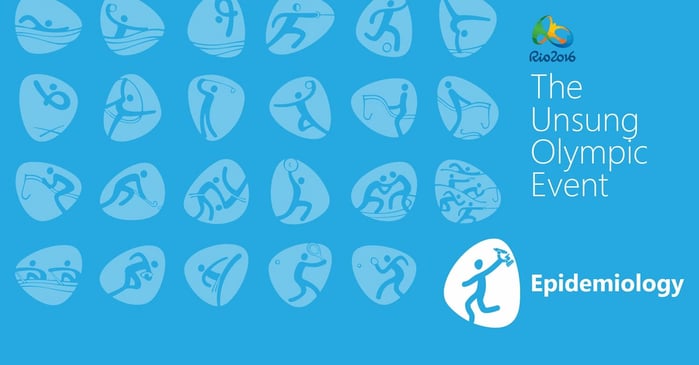Epidemiology: The Unsung Olympic Event, Part 1

 We are now well into the first week of the 2016 Olympics in Rio de Janeiro, Brazil. The first medals have been awarded and the pre-opening frenzy about incomplete structures has calmed down. One concern, however, keeps coming up – the health of those competing in and attending these games of the XXXI Olympiad. More specifically, the threat of the Zika virus and bacteria in the water. This issue has made us wonder about the history of the intersection of the Olympics and infectious diseases has led to our determination that the most important event at any Olympics is the one you never hear about: Epidemiology.
We are now well into the first week of the 2016 Olympics in Rio de Janeiro, Brazil. The first medals have been awarded and the pre-opening frenzy about incomplete structures has calmed down. One concern, however, keeps coming up – the health of those competing in and attending these games of the XXXI Olympiad. More specifically, the threat of the Zika virus and bacteria in the water. This issue has made us wonder about the history of the intersection of the Olympics and infectious diseases has led to our determination that the most important event at any Olympics is the one you never hear about: Epidemiology.
The Olympics have always stood for the coming together of the people of the world in peace. Lots of people. This global event, which brings not only athletes but support staff and spectators from around the planet, also provides an opportunity for infectious diseases to spread rapidly. Large crowds enable microorganisms to spread more effectively on location, and then to also travel back to areas around the world along with their hosts. For this reason, the Olympics, along with other huge athletic and religious events, are defined as and considered a special scenario by epidemiologists worldwide: Mass gatherings.
|
Mass Gatherings: Attendance Perspective These events which drew record-breaking visitors from around the globe. |
|
2007 Kumbh Mela 70 million visitors over 55 days 2012 Hajj 3 million visitors over 5 days 1994 World Cup 3.6 million visitors over 30 days 1996 Atlanta Summer Olympics 8.3 tickets sold; 500,000 spectators per day over 14 days |
Events categorized by the World Health Organization as mass gatherings are typically religious or athletic in nature, and many have contributed to the spread of infectious disease. The largest of these events, a Hindu pilgrimage that today draws millions of visitors to areas near the Ganges River, may have been the cause of the cholera pandemic that claimed millions of lives worldwide in the early 19th Century. Another massively attended pilgrimage is the Hajj, which brings millions of people to Mecca, Saudi Arabia each year, a concentration of visitors that has enabled diseases such as MERS, infection by N. meningitidis, and H1N1 to spread world-wide.
Athletic events, while smaller (see table), have also been hit by outbreaks. An outbreak of the chicken pox affected the 2006 Asian Games, while that same year norovirus spread during the FIFA World Cup in Germany. And outbreaks of leptospirosis affected participants of the 2000 Eco-Challenge in Malaysia, a jungle-based competition which also resulted in tick-bite fever. Skin infections, stomach bugs and viruses have all spread easily during these and other international sports events. However, thanks to the advance preparation of epidemiologists and other health officials, these events are planned with disease in mind, avoiding much worse outbreaks.
For this reason, the Olympics have not had any massive outbreaks, despite their relatively large size as compared to other international athletic events. Only two outbreaks in the 100+ years of competition have been recorded: A measles outbreak during the 2010 Winter Olympics in Vancouver and a small outbreak of influenza at the 2002 Winter Olympics in Salt Lake City. In both cases, the advance preparation, guided by principles founded in epidemiology, enabled quick and effective response to these outbreaks.
There has been no shortage of headlines about the biological threats of illness facing attendees and participants in the 2016 Summer Olympics. Yet the games continue. Stay tuned to find out why the torch remained on track for Rio and what it really takes to throw in the towel against the threat of disease.
![EOScu Logo - Dark - Outlined [07182023]-01](https://blog.eoscu.com/hubfs/Eoscu_June2024/Images/EOScu%20Logo%20-%20Dark%20-%20Outlined%20%5B07182023%5D-01.svg)




